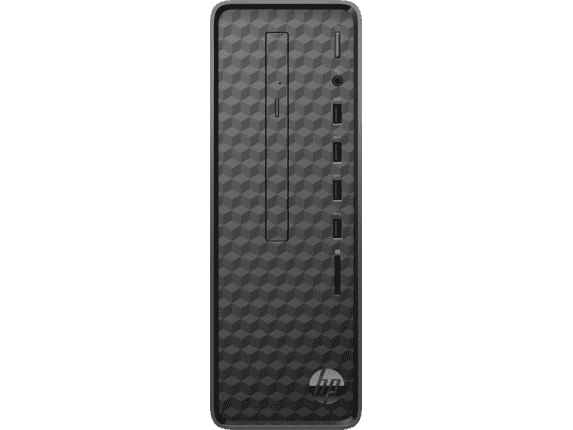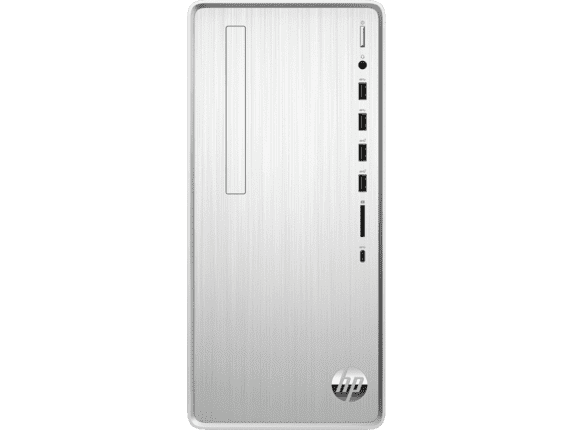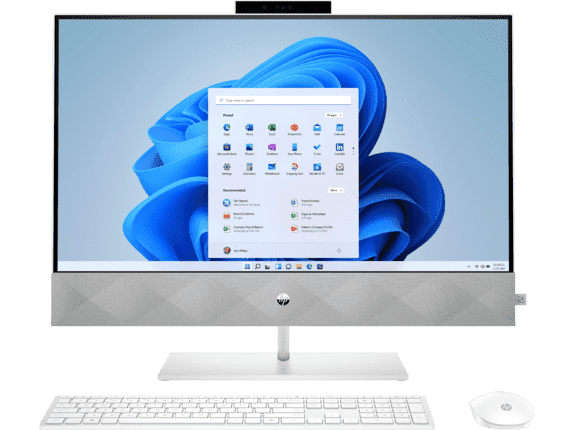Thank you for visiting the SG HP Store
-
Contact Us
CONTACT USCall us
- Sales
- 1800 278 0182
- Technical support
- +6562725300
Mon-Fri 8.30am - 5.30pm
(exc. Public Holidays)
Chat with us- Sales
- 6531292625(WhatsApp)
-

Mon-Fri 8.30am - 5.30pm
(exc. Public Holidays)
Live product demo
- My Account
Desktop PC vs. All-In-One Computer


If you’re in the market for a new computer, the options can be overwhelming. Do you want a laptop? Or is a desktop better suited to your needs? Or maybe you’re interested in the streamlined all-in-one computer?
While you may be familiar with how a laptop differs from a traditional desktop, the difference between a desktop and an all-in-one is not as straightforward. Here are the major perks and downsides of each type of computer, along with the best models on the market today.
What is a Desktop PC?
A desktop PC is the most traditional version of a stationary computer. It’s typically a tower or case that holds the processor, memory, video card, and internal components that make the PC work. To use it, you need to buy additional accessories, such as a monitor, speakers, keyboard, and mouse.
PROS OF THE DESKTOP PC
Why do some people prefer a desktop PC? Take a look at the following perks.
1. It offers a completely customizable configuration because you’ll buy the monitor, speakers, and other accessories separately. Pick the extras that work best for your daily tasks and budget, and enjoy more options when deciding what internal hardware to include.
2. It's easier to repair. Since you can open the standard desktop’s case with minimal effort, you won’t struggle to get inside and repair the PC. You can do many simple fixes on your own, such as cleaning a fan or replacing a cable, and you don’t have to worry about taking the monitor apart with special tools.
3. It’s easier to upgrade. Whether you want a faster processor or a new graphics card to play the latest games, this is a simple task, thanks to the tower’s accessibility.
4. It’s more affordable. Because you need to buy the monitor and speakers separately, the initial investment price for a desktop PC may be lower than an all-in-one. This is especially true if you buy a smaller, budget-friendly monitor or share a monitor with other devices.
5. It’s generally more powerful. While there are exceptions, the processors offered with today’s desktop PCs are often more robust than those in all-in-ones. If you are into virtual reality or need a powerful processor for video rendering, you can customize your PC to fit your needs.
CONS OF THE DESKTOP PC
Here are some potential disadvantages of owning a desktop PC.
1. You must do additional shopping. If you want to make a single purchase and set it up without buying anything else, a desktop isn’t for you. You have to research and buy at least a monitor, keyboard, and mouse that fit into your workflow.
2. It takes up more space. While desktop towers are becoming slimmer and more low-profile, you must find room for a monitor and computer at your workstation. This small difference can take up ample space in an already cramped environment. Desktops aren't as aesthetically pleasing as some of the newer all-in-ones, so they may not blend into your setup.
3. It is more difficult to move. Have you ever tried to take your desktop with you? It can be a chore, including unplugging the monitor and picking up three or more computer components for transportation. This is a bulky and heavy task that isn't as much of an issue with all-in-ones.
What is an All-in-One Computer?


The all-in-one (AiO) PC combines a desktop computer, including the processor, memory, graphics, and storage, with a monitor and speakers into a single piece of equipment. This means you can’t separate the computer from the monitor. That makes it similar to a laptop, though an AiO is larger and designed to sit stationary on a desk.
PROS OF THE ALL-IN-ONE COMPUTER
What makes AiO PCs special? Fans of this computer design like the following:
1. It takes up less space. With the monitor built right into the PC, you have fewer things to fit into already-tight spaces. The overall design is more compact, too.
2. It’s easier to set up and start using. All-in-ones are the most “plug-and-play” option available.
3. It comes with everything. There’s no need to shop around for the best monitor or speakers. You get exactly what you need to use it – right out of the box.
4. It’s easy to transport. While all-in-ones are typically part of a stationary workstation, they’re not complicated to move. They’re usually on the lighter side, allowing you to move it elsewhere with little fuss.
5. It can come with a touch screen. Today’s all-in-ones use the latest monitor tech, including brilliant color displays and responsive touch options.
CONS OF THE ALL-IN-ONE COMPUTER
But are there any cons? Here are some to consider:
1. It’s more challenging to repair yourself. Because the monitor and the computer are combined in one case, you may struggle to get into it and require professional assistance.
2. It’s harder to upgrade. Again, the design makes getting inside the device complicated. Also, there may be less room available for upgrades, so adding storage or larger fans may be difficult – if not impossible.
3. It's typically not as powerful. What you get in convenience, you may miss in power. Today's all-in-ones come with a range of processors and graphics cards, but they are typically designed for more everyday use.
4. It’s not customizable. Aside from a few options at checkout, buying an all-in-one means you get what you get. You can’t mix in a monitor from a different manufacturer, either.
Best Desktop PCs
If you’ve decided on a desktop, you can’t go wrong with these choices:
HP SLIM S01-PF1025SE DESKTOP PC


The HP Slim desktop PC’s streamlined design and integrated DVD-writer drive make this a great everyday PC you can buy at an affordable price. Its key features include:
• 10th generation Intel® Core™ i3 processor
• 8GB memory, 1TB HDD storage, and 128GB SSD storage
• Supports WiFi 5 and Ethernet adapter
• Beautiful, space-saving design
HP ENVY DESKTOP TE01-1150XT


If you need a budget-friendly, all-around solid desktop, this HP ENVY desktop is hard to beat. The base model boasts the specs you need to stream, edit, and do your best work, including:
• Intel Core i3-10100 processor
• Integrated graphics, up to 12GB GDDR6
• 3-in-1 media card readers
• 5.1 surround sound capabilities
HP PAVILION DESKTOP TP01-2165Z PC


This sleek, silver HP Pavilion desktop uses multiple ports and the latest AMD technology to deliver excellent results. It also features:
• AMD Ryzen™ 5 processor
• AMD Radeon graphics
• 16GB memory, 2TB HDD storage, and 256GB SSD storage
• DVD-writer
Best All-in-One Computers
Are you thinking of buying an AIO? These models top the list.
HP PAVILION ALL-IN-ONE - 27-D0255XT TOUCH OPTIONAL


The 27-inch HP Pavilion All-in-One is more than just a powerful AIO – it also comes with all the ports and perks you need. You can even upgrade it to include a touch screen, making for a beautiful and clutter-free work experience. Other perks include:
• Intel Core i5-10400T processor
• NVIDIA® GeForce® MX 350 graphics
• 8GB DDR4-2666 SDRAM
• Pop-up privacy camera
• Bang & Olufsen speakers
• 27-inch display with up to 4K resolution
HP ALL-IN-ONE 22-DF10266T PC


The 22-inch HP All-in-One is a thoughtfully designed PC with an easily removable panel, so you can perform repairs or upgrades in a snap. Additional benefits include:
• 11th Generation Intel Core i3 processor
• Intel UHD Graphics
• 21.5-inch diagonal, anti-glare Full HD display
• Pop-up privacy camera
• 8GB memory, 1TB HDD storage, and 128GB storage
HP CHROMEBASE ALL-IN-ONE 22-AA0130XT DESKTOP


Google fans will love the HP Chromebase All-in-One, which feels like an HP Chromebook with a built-in, sharp 21.5-inch Full High Definition (FHD) display. Its top features include:
• 10th Generation Intel Core i3 processor
• 12GB memory and 256GB SSD storage
• 90-degree pivoting display
• Camera privacy switch
• Parental controls built into the Chrome OS
All-in-One vs. Desktop: Which is Right for You?
Choosing between a desktop vs. all-in-one computer requires you to really think about your days and evenings, as well as the kinds of tasks you perform. If you rely on a PC for process-intensive work projects that will need upgrades over time, a traditional desktop PC offers flexibility and durability.
On the other hand, if you want a plug-and-play solution that gives you a great all-around experience that’s also versatile, you may gravitate toward an AiO computer. Today’s AiOs are much more advanced than those of the past, and they’re often easier to upgrade and repair. Plus, they deliver brilliant audio-visual perks to match their space-saving aesthetics.
AiO computers are also a great fit for those who work from home or homeschool. You can easily fit these PCs into any area of the home. Plus, it’s a breeze to set up multiple users, so your child can use their login to finish homework before you log in later to respond to work emails. You also have fewer accessories to worry about, making for a cleaner, more streamlined workspace.
Of course, nothing says you have to choose one over the other. Large families and workplaces may choose one of each to suit the needs of the individual users.
About the Author: Linsey Knerl is a contributing writer for HP Tech Takes. Linsey is a Midwest-based author, public speaker, and member of the ASJA. She has a passion for helping consumers and small business owners do more with their resources via the latest tech solutions.
- Sales
- 1800 278 0182
- Technical support
- +6562725300
Mon-Fri 8.30am - 5.30pm
(exc. Public Holidays)
- Sales
- 6531292625(WhatsApp)
-

Mon-Fri 8.30am - 5.30pm
(exc. Public Holidays)
Live product demo












